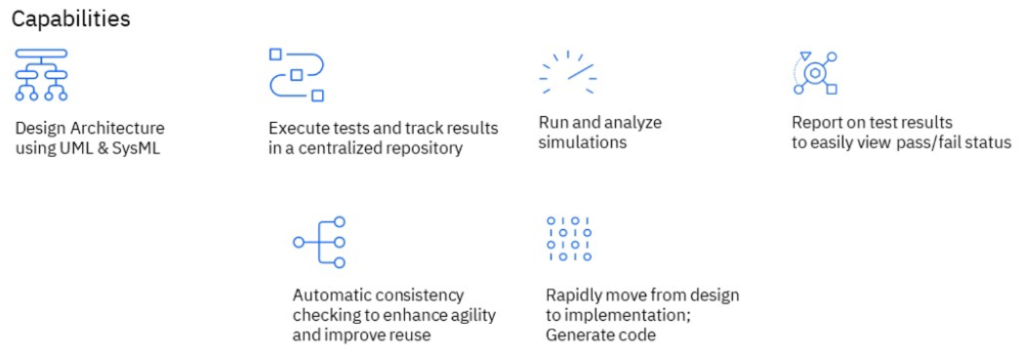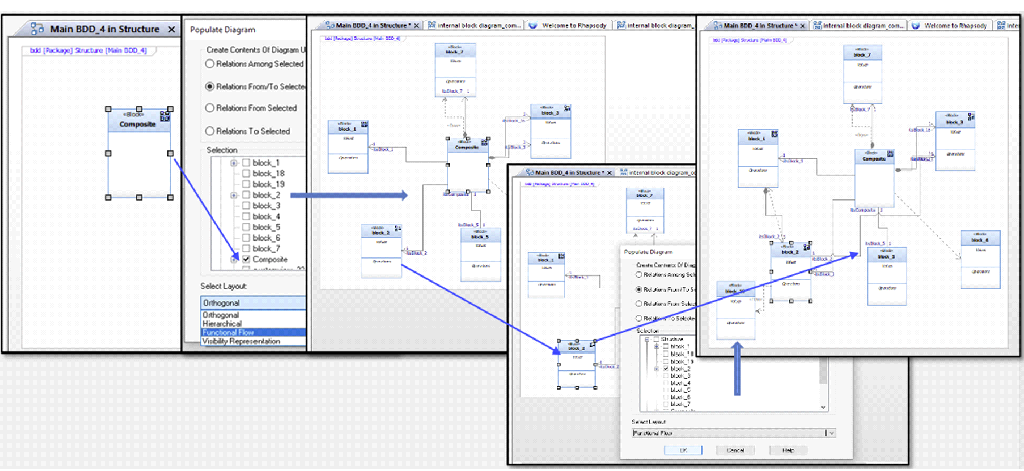IBM Engineering Systems Design Rhapsody
IBM Engineering Systems Design Rhapsody
Welcome to IBM Engineering Systems Design Rhapsody, a powerful tool designed to assist engineers in visualizing, simulating, and analyzing complex systems and architectures. Whether you’re developing embedded software, control systems, or cyber-physical systems, Rhapsody offers a comprehensive solution to streamline your design process and accelerate innovation.
Rhapsody enables organizations to manage the complexity inherent in modern product and system development processes. Its fast simulation and prototyping features facilitate early error detection and continuous system verification. Additionally, its integration capabilities with other design tools like MathWorks Simulink ensure integrity throughout the engineering lifecycle.
IBM Rhapsody provides flexible solutions, based on SysML/UML, that focus on the needs of systems engineers and embedded software developers. Tailored solutions are available for AUTOSAR, multicore, Android, MARTE, DDS, DoDAF, MODAF, UPDM and the UML testing profile. You can even create your own custom domain-specific language, using profiles and helpers to automate your development.
Rhapsody Capabilities

Key Features
Model-Based Design: Rhapsody employs a model-based design approach, allowing engineers to create visual representations of system architectures, behavioral models, and state machines. This intuitive modeling environment enables clear communication and collaboration across multidisciplinary teams.
Simulation and Analysis: With Rhapsody, engineers can simulate and analyze system behavior in real-time. From performance analysis to fault detection, Rhapsody provides powerful simulation capabilities to validate system designs and identify potential issues early in the development process.
Code Generation: Rhapsody offers built-in code generation capabilities, allowing engineers to automatically generate production-quality code from their models. This seamless integration between modeling and code generation accelerates development cycles and ensures consistency between design and implementation.
Integration with Engineering Lifecycle Tools: Rhapsody seamlessly integrates with other tools within the IBM Engineering Lifecycle Management (ELM) Platform, including requirements management, workflow management, and test management tools. This integration enables end-to-end traceability and ensures alignment between system requirements, design artifacts, and test cases.
Customization and Extensibility: Rhapsody provides a flexible and extensible platform that can be tailored to meet the unique needs of different industries and domains. With support for industry standards and open APIs, Rhapsody empowers engineers to customize their workflow and extend the tool’s capabilities to address specific challenges.
Simulation and Analysis

Benefits
- Improved Collaboration: Rhapsody facilitates collaboration among multidisciplinary teams by providing a common platform for visualizing and communicating system designs.
- Faster Time-to-Market: By streamlining the design process and automating code generation, Rhapsody helps accelerate development cycles and reduce time-to-market for new products and systems.
- Enhanced Quality and Reliability: With comprehensive simulation and analysis capabilities, Rhapsody enables engineers to validate system designs and identify potential issues early, leading to improved quality and reliability of the final product.
- Seamless Integration: Rhapsody seamlessly integrates with other tools within the IBM ELM Platform, providing end-to-end traceability and ensuring alignment between requirements, design, and testing activities.
There are different offerings of Rhapsody tailored for specific needs and environments. Some of them are:
- IBM Engineering Systems Design Rhapsody – Designer for Software: Tailored for software developers integrating system designs with software processes. It offers code generation, integration, debugging, and collaboration tools for seamless translation of designs into code, testing, and deployment
- IBM Engineering Systems Design Rhapsody – Designer for Systems Engineers: Geared towards system engineers managing complex architectures. It provides advanced modeling, SysML support, integration with requirements tools, simulation, and documentation features for effective system architecture management.
- IBM Engineering Systems Design Rhapsody – Architect for Systems Engineers: It is a robust modeling and design tool that enables systems engineers to create and manage complex system architectures. It provides a comprehensive environment for designing, analyzing, and simulating systems, ensuring alignment with industry standards and practices. The tool facilitates model-based systems engineering (MBSE) by integrating requirements, design, and implementation processes. It supports various modeling languages, including SysML and UML, enhancing communication and collaboration among engineering teams. The platform’s capabilities streamline the development lifecycle, improve design quality, and reduce time-to-market for complex systems
- IBM Engineering Systems Design Rhapsody – Architect for Software: It is an advanced modeling and design solution tailored for software engineers. It facilitates model-driven development by integrating design, simulation, and validation of software components within a unified environment. The tool supports industry-standard languages like UML, enabling engineers to create detailed and accurate software models. By providing comprehensive analysis and design capabilities, Rhapsody Architect helps streamline development processes, enhance code quality, and reduce time-to-market. Its collaborative features improve team communication and coordination, making it an essential tool for modern software engineering projects.
- IBM Engineering Systems Design Rhapsody – Developer: This edition is tailored for software developers and engineers who need to integrate system designs with software implementation, testing, and deployment processes.
- IBM Engineering Systems Design Rhapsody – Modeler:This edition focuses on providing powerful modeling capabilities for visualizing system architectures, behavioral models, and state machines. It supports Model-Based Systems Engineering (MBSE) by facilitating the creation of models using industry standards like UML, SysML, and UAF. Rhapsody – Modeler allows for the design and simulation of complex systems, enabling early validation of system behaviors and ensuring compliance with design requirements. Additionally, it supports the generation of production code from models, allowing seamless transition from design to implementation, and enhances collaboration among engineers through integrated modeling and design tools.
- IBM Engineering Systems Design Rhapsody – Model Manager: This edition is dedicated to the management and lifecycle of engineering models, providing robust version control, traceability, and collaborative capabilities. It ensures end-to-end traceability between different lifecycle artifacts such as requirements, design models, and test cases. Rhapsody – Model Manager enables teams to share, review, and manage models using a central repository with web-based access, facilitating effective collaboration among stakeholders. Additionally, it supports configuration management, allowing for the handling of different versions and variants of models, ensuring consistency and compliance across various system configurations. By integrating with other IBM Engineering Lifecycle Management tools, it provides comprehensive lifecycle support, enhancing the overall quality and traceability of engineering projects.
Rhapsody Model Manager

